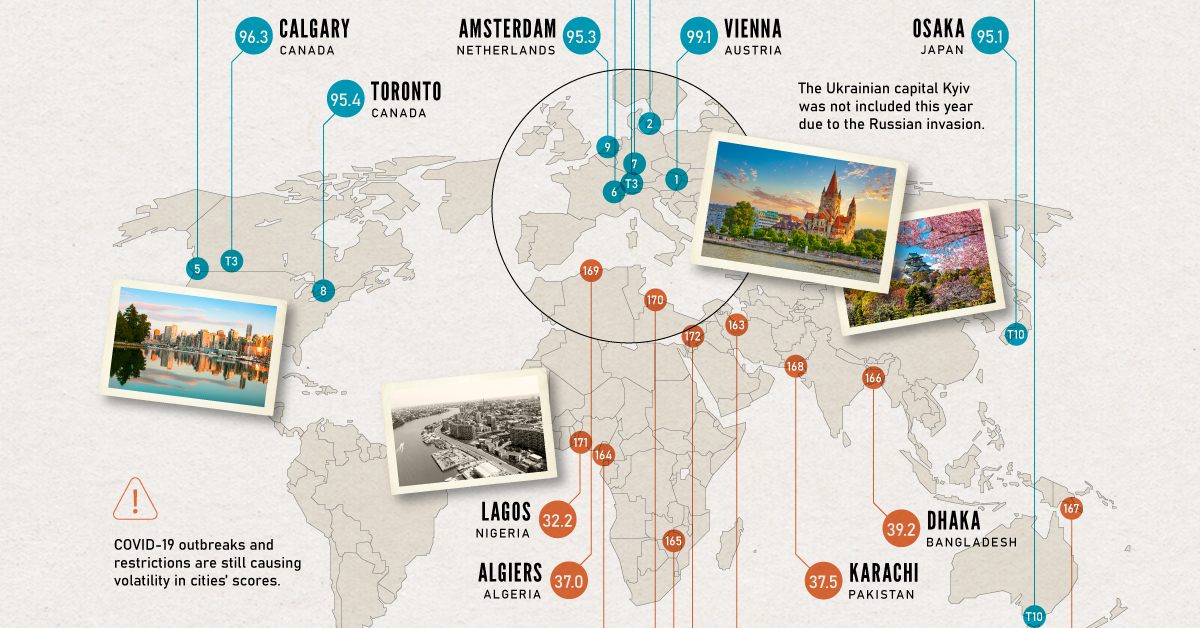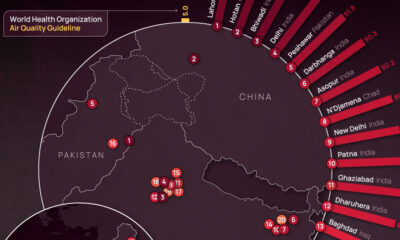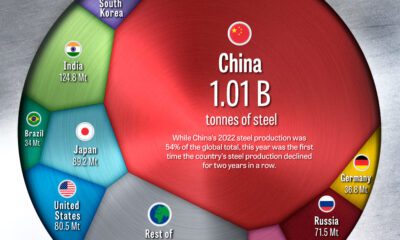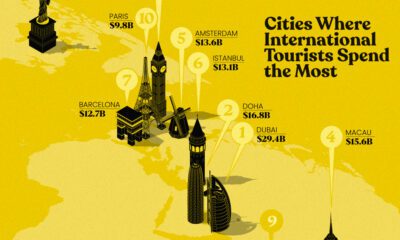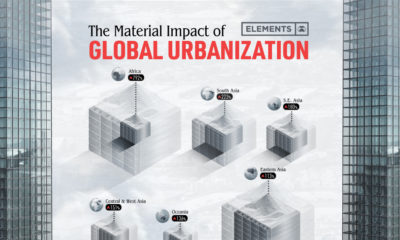Economy
Ranked: The Most and Least Livable Cities in 2022
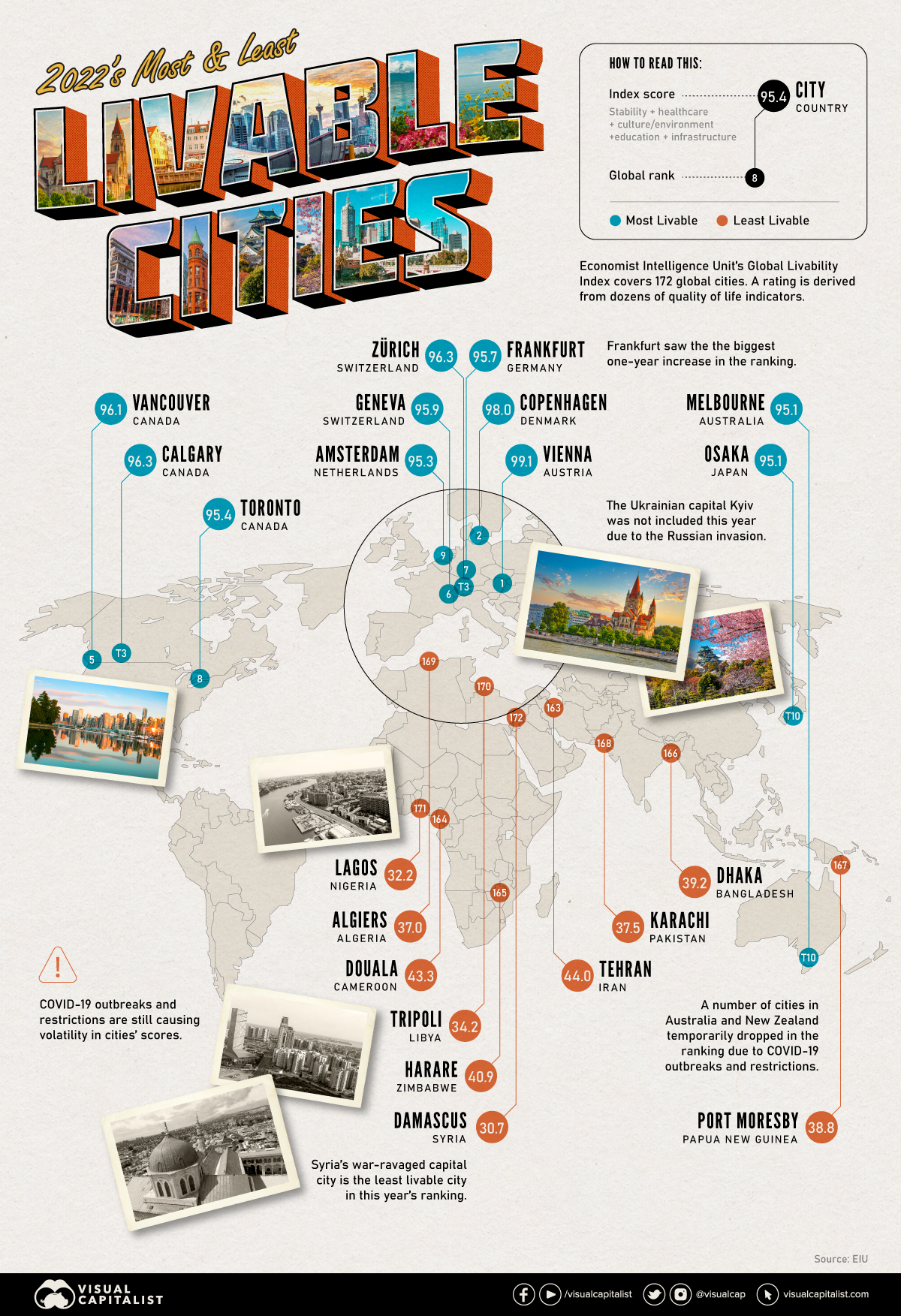
Ranked: The Most and Least Livable Cities in 2022
Pandemic restrictions changed the livability of many urban centers worldwide as cultural sites were shuttered, restaurant dining was restricted, and local economies faced the consequences. But as cities worldwide return to the status quo, many of these urban centers have become desirable places to live yet again.
This map uses annual rankings from the Economist Intelligence Unit (EIU) to show the world’s most livable cities, measuring different categories including: stability, healthcare, culture and environment, education, and infrastructure.
A Quick Note on Methodology
The ranking attempts to assess which cities across the globe provide the best living conditions, by assigning a score on 30 quantitative and qualitative measures across the five categories with the following weightings:
- Healthcare (20%)
- Culture & Environment (25%)
- Stability (25%)
- Education (10%)
- Infrastructure (20%)
Of the 30 factors within these categories, the qualitative ones are assigned as acceptable, tolerable, uncomfortable, undesirable, or intolerable by a team of expert analysts. Quantitative measures are given a score based on a number of external data points. Everything is then weighted to provide a score between 1-100, with 100 being the ideal.
Ranked: The 10 Most Livable Cities
Of the 172 cities included in the rankings, many of the most livable cities can be found in Europe. However, three of the top 10 are located in Canada: Vancouver, Calgary, and Toronto.
Vienna has been ranked number one many times, most recently in 2019. According to the EIU, the Austrian capital only fell out of the top slot during the pandemic years because its famous museums and restaurants were shuttered.
| Rank | City | Country | Score |
|---|---|---|---|
| #1 | Vienna | 🇦🇹 Austria | 99.1 |
| #2 | Copenhagen | 🇩🇰 Denmark | 98.0 |
| #3 | Zurich | 🇨🇭 Switzerland | 96.3 |
| #3 | Calgary | 🇨🇦 Canada | 96.3 |
| #5 | Vancouver | 🇨🇦 Canada | 96.1 |
| #6 | Geneva | 🇨🇭 Switzerland | 95.9 |
| #7 | Frankfurt | 🇩🇪 Germany | 95.7 |
| #8 | Toronto | 🇨🇦 Canada | 95.4 |
| #9 | Amsterdam | 🇳🇱 Netherlands | 95.3 |
| #10 | Osaka | 🇯🇵 Japan | 95.1 |
| #10 | Melbourne | 🇦🇺 Australia | 95.1 |
Only one Asian city, Osaka, makes the top 10 list, tying with Melbourne for 10th place. Notably, not a single U.S. city is found in the top ranks.
Editor’s note: Two cities tie for both the #3 and #10 ranks, meaning that the “top 10” list actually includes 12 cities.
Ranked: The 10 Least Livable Cities
Some of the least livable cities in the world are located across Africa and Central Asia.
| Rank | City | Country | Score |
|---|---|---|---|
| #163 | Tehran | 🇮🇷 Iran | 44.0 |
| #164 | Douala | 🇨🇲 Cameroon | 43.3 |
| #165 | Harare | 🇿🇼 Zimbabwe | 40.9 |
| #166 | Dhaka | 🇧🇩 Bangladesh | 39.2 |
| #167 | Port Moresby | 🇵🇬 Papua New Guinea | 38.8 |
| #168 | Karachi | 🇵🇰 Pakistan | 37.5 |
| #169 | Algiers | 🇩🇿 Algeria | 37.0 |
| #170 | Tripoli | 🇱🇾 Libya | 34.2 |
| #171 | Lagos | 🇳🇬 Nigeria | 32.2 |
| #172 | Damascus | 🇸🇾 Syria | 30.7 |
Many of the least livable cities are within conflict zones, contributing to the low ratings. However, these regions are also home to some of the world’s fastest growing cities, presenting many opportunities for ambitious residents.
The Biggest Changes in Ranking
Let’s take a look at the cities that moved up the global rankings most dramatically compared to last year’s data.
Moving Up: The 10 Most Improved Cities
| City | Country | Overall Rank | Rank Change |
|---|---|---|---|
| Frankfurt | 🇩🇪 Germany | #7 | +32 |
| Hamburg | 🇩🇪 Germany | #16 | +31 |
| Dusseldorf | 🇩🇪 Germany | #22 | +28 |
| London | 🇬🇧 UK | #33 | +27 |
| Manchester | 🇬🇧 UK | #28 | +26 |
| Paris | 🇫🇷 France | #19 | +23 |
| Brussels | 🇧🇪 Belgium | #24 | +22 |
| Amsterdam | 🇳🇱 Netherlands | #9 | +21 |
| Athens | 🇬🇷 Greece | #73 | +19 |
| Los Angeles | 🇺🇸 US | #37 | +18 |
Here’s a look at the cities that fell the most in the rankings since last year’s report.
Moving Down: The 10 Cities That Tumbled
| City | Country | Overall Rank | Rank Change |
|---|---|---|---|
| Wellington | 🇳🇿 New Zealand | #50 | -46 |
| Auckland | 🇳🇿 New Zealand | #34 | -33 |
| Adelaide | 🇦🇺 Australia | #30 | -27 |
| Perth | 🇦🇺 Australia | #32 | -26 |
| Houston | 🇺🇸 US | #56 | -25 |
| Reykjavik | 🇮🇸 Iceland | #48 | -25 |
| Madrid | 🇪🇸 Spain | #43 | -24 |
| Taipei | 🇹🇼 Taiwan | #53 | -20 |
| Barcelona | 🇪🇸 Spain | #35 | -19 |
| Brisbane | 🇦🇺 Australia | #27 | -17 |
According to the report, a number of cities in New Zealand and Australia temporarily dropped in the ranking due to COVID-19 restrictions.
It’s also worth noting that some Eastern European cities moved down in the rankings because of their close proximity to the war in Ukraine. Finally, Kyiv was not included in this year’s report because of the conflict.
Urbanization and Livability
As of 2021, around 57% of the world’s population lives in urban centers and projections show that people worldwide will continue to move into cities.
While there are more amenities in urban areas, the pandemic revealed many issues with urbanization and the concentration of large populations. The stress on healthcare systems is felt most intensely in cities and restrictions on public outings are some of the first measures to be introduced in the face of a global health crisis.
Now with the cost of living rising, cities may face pressures on their quality of life, and governments may be forced to cut spending on public services. Regardless, people worldwide continue to see the benefits of city living—it’s projected that over two-thirds of the global population will live in cities by 2050.
Politics
How Do Chinese Citizens Feel About Other Countries?
What is the Chinese public’s view of world powers? This visual breaks down Chinese sentiment towards other countries.
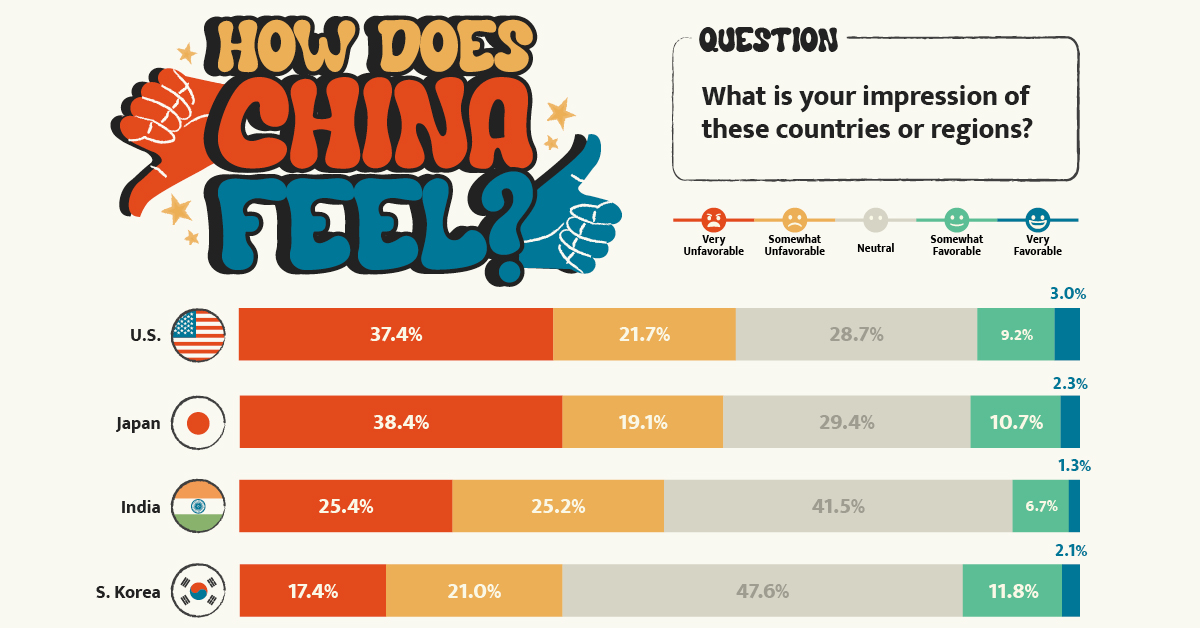
Public Opinion: How Chinese Citizens Feel About Other Countries
Tensions over Taiwan, the COVID-19 pandemic, trade, and the war in Ukraine have impacted Chinese sentiment towards other countries.
This visualization uses data from the Center for International Security and Strategy (CISS) at Tsinghua University to rank survey responses from the Chinese public on their attitudes towards countries and regions around the world.
Chinese Sentiment Towards Other Countries in 2023
In the Center’s opinion polls, which surveyed a random sample of more than 2,500 Chinese mainland adults in November 2022, Russia came out significantly ahead.
Just under 60% of respondents held Russia in a favorable view, with 19% seeing the country as “very favorable.” Contrast that to the mere 12% that viewed the U.S. in a positive light.
Here’s a closer look at the data. The percentages refer to the share of respondents that voted for said category.
| Country/Region | Very Unfavorable | Somewhat Unfavorable | Neutral | Somewhat Favorable | Very Favorable |
|---|---|---|---|---|---|
| 🇺🇸 United States | 37.4% | 21.7% | 28.7% | 9.2% | 3.0% |
| 🇯🇵 Japan | 38.4% | 19.1% | 29.4% | 10.7% | 2.3% |
| 🇮🇳 India | 25.4% | 25.2% | 41.5% | 6.7% | 1.3% |
| 🇰🇷 South Korea | 17.4% | 21.0% | 47.6% | 11.8% | 2.1% |
| 🇪🇺 European Union | 9.3% | 15.6% | 57.6% | 14.1% | 3.3% |
| Southeast Asia | 7.1% | 13.1% | 59.5% | 16.8% | 3.5% |
| 🇷🇺 Russia | 3.0% | 4.8% | 33.7% | 39.4% | 19.0% |
Japan ranked just below the U.S. in terms of overall unfavorability, though a slightly higher share of respondents saw Japan as “very unfavorable” compared to America. This is likely due to both modern tensions in the East China Sea over mutually claimed islands and historical tensions over the Sino-Japanese Wars.
Chinese sentiment towards India was also unfavorable at just over 50%, though notably the country also received the lowest favorability rating at just 8%.
Additional Survey Findings
The survey also found that 39% of Chinese people get their information on international security from Chinese state-run media (mainly through TV), with an additional 19% getting information from government websites and official social accounts. Conversely, only 1.7% get their news from foreign websites and foreign social media, partially due to the Great Firewall.
When asked about different international security issues, the biggest shares of Chinese citizens ranked the following as their top three:
- Pandemics (12.9%)
- Disputes over territory and territorial waters (12.9%)
- China-U.S. relations (12.0%)
The pandemic’s high score reflects the harsher impact COVID-19 had on China. Chinese borders were shut for years and the public faced intense measures to reduce spread.
In terms of other world events, the majority of Chinese people align with a more “Eastern” viewpoint. For example, in regards to the war in Ukraine, the report found that:
“About 80 percent of the respondents believe the U.S. and Western countries should be held most accountable [for the war], while less than ten percent of the respondents argue that Russia is mainly responsible.”– Center for International Security and Strategy, Tsinghua University
Overall, the views of the Chinese public reflect the opposite of those found in many Western countries. They provide an important insight that it is not just the Chinese government holding particular views about the world, but the Chinese public as well.
-

 Maps7 days ago
Maps7 days agoMapped: The Safest Cities in the U.S.
-

 Markets2 weeks ago
Markets2 weeks agoRanked: The Most Profitable U.S. Companies, by Sector
-

 apps5 days ago
apps5 days agoHow Long it Took for Popular Apps to Reach 100 Million Users
-

 Markets4 weeks ago
Markets4 weeks agoThe World’s Biggest Mutual Fund and ETF Providers
-

 Brands2 weeks ago
Brands2 weeks agoBrand Reputations: Ranking the Best and Worst in 2023
-

 Environment5 days ago
Environment5 days agoHotter Than Ever: 2023 Sets New Global Temperature Records
-

 Datastream4 weeks ago
Datastream4 weeks agoCan You Calculate Your Daily Carbon Footprint?
-

 Energy2 weeks ago
Energy2 weeks agoWho’s Still Buying Russian Fossil Fuels in 2023?

